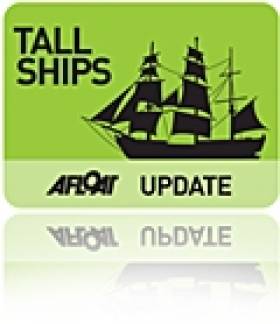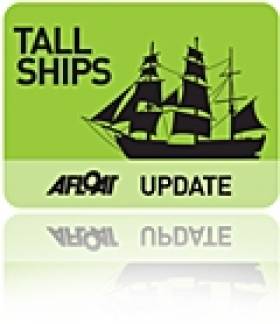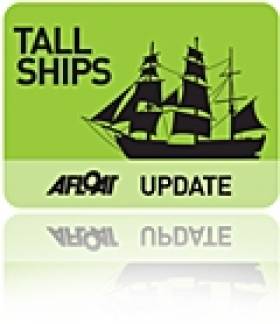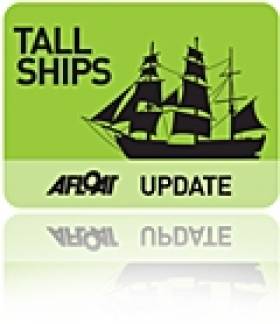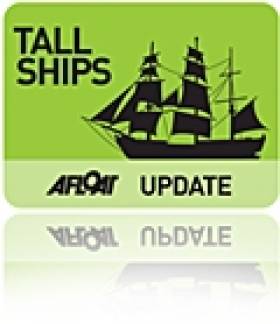Displaying items by tag: Tall Ships
IWDG Secures 75% Funding for Celtic Mist Refit
#TALL SHIPS - The Irish Whale and Dolphin Group (IWDG) has secured three-quarters of the funding it required to refit its research vessel Celtic Mist.
According to The Irish Times, the Clare Local Development Company has approved the allocation of a €48,000 grant towards the refurbishment of the ketch.
The work will be carried out by Cathal Blunnie and several sub-contractors, and involves stripping down the main cabin and removing the bath and shower to increase space for crew berths.
While the ship's clock will be retained, the ship’s wheel in the main cabin will be removed and presented to the Haughey family as a gesture of appreciation.
As previously reported on Afloat.ie, the 52-foot yacht - which was gifted by the Haughey family to the IWDG to assist in its marine wildlife conservation work - entered dry dock last November in preparation for the refit work, after relocating to its new berth at Kilrush, Co Clare in July.
This followed its last jaunt at sea in its former guise, completing a leg of the Tall Ships Races from Waterford to Greenock in Scotland.
The cost of refurbishing the yacht for research and training purposes is expected to top €60,000, with an annual running cost of some €20,000, for which the IWDG is seeking ongoing financial assistance.
The group aims to get the Celtic Mist back at sea before the summer.
Tall Ships Conference Sets Sail for Aalborg, Denmark
#TALL SHIPS – The port city of Aalborg, Denmark, will host Sail Training International's annual Tall Ship conference in November 2013. The agreement was signed today by Aalborg Mayor Henning G Jensen and Sail Training International's President and Chairman Nigel Rowe.
The two day event is expected to bring close to 400 delegates from about 40 countries to the city for a series of plenary and work-shop sessions on a range of topics relating to sail training for young people and Tall Ships races. Half the delegates will be from ports around the world that host Tall Ships events. Half will be the owners and operators of sail training vessels. Aalborg has hosted Sail Training International's Tall Ships Races several times in the past, most recently in 2010. It is contracted to do so again in 2015. Aalborg also has a long-standing reputation as a 'sail training friendly' port and supports its two local sail training vessels Jens Krogh and LOA.
"It is very unusual for us to contract with a host city for our conference so far in advance; but the opportunity to do so with Aalborg now was one we were very keen to take", says Nigel Rowe. "Aalborg has been a highly successful host port for our Tall Ships Races in the past, and a great supporter over many years of sail training and Sail Training International in other ways too. 2013 will be Mayor Henning G Jensen's last year in office and we welcome this opportunity to thank him for his support in the past, and the community of Aalborg too."
"Aalborg has a strong maritime tradition and our community has developed a great affection for the Tall Ships over the years," says Mayor Henning G Jensen. "The Tall Ships Races give us an opportunity to show-case our city and Danish hospitality to an international fleet and thousands of young people and media from around the world. They give our own community an opportunity for a family-friendly party ... and they bring economic benefits to the city as well. Hosting this important and prestigious international conference is an honour and will be great for our city."
Belfast to Welcome Tall Ships in 2015
#TALL SHIPS - Ireland will be getting a triple dose of the Tall Ships Races this decade - after Waterford last year and Dublin next summer - as Belfast has been chosen to host the first leg of the event in 2015, BBC News reports.
Belfast City Council made the official announcement this afternoon, with Belfast Lord Mayor Niall O Donnghaile saying the return of the event in July 2015 was "another very real endorsement of Belfast's ability".
Northern Ireland's capital last hosted the tall ships in 2009, when some 800,000 visitors thronged the city to see 40 vessels in a parade of sail.
BBC News has more on the story HERE.
Entry List Announced for Tall Ships Races 2012
#TALL SHIPS - Eighteen vessels are on the entry list for the 2012 Tall Ships Races which are set to conclude in Dublin Port next August.
The list is dominated by British entries, with all nine UK tall ships expected to sail the third and final leg from A Coruña in northern Spain to Dublin.
Tall ships from Russia, Poland, France, Ecuador, Bulgaria, Latvia, Estonia and Belgium will also be in the fray when Ireland's capital hosts the final port of call for the 2012 races, presented by Szczecin in Poland and organised by Sail Training International - a charity established to harness sail training to develop and educate young people regardless of nationality, culture, religion, gender or social background.
The first leg of the 2012 races kicks off in Saint-Malo, France on 7 July with ships racing to Lisbon in Portugal (till 21 July); Cádiz in southern Spain (21-28 July) and A Coruña (28 July-12 August) before the final leg.
Dublin will be hosting the Tall Ships Races for the first time since 1998. Earlier this year Eamonn O’Reilly, CEO of Dublin Port Company, said he was “delighted to welcome the Tall Ships Races to Dublin Port" in 2012.
Since the announcement the port has already played host to the British tall ship Tenacious and the Norwegian vessel S/S Statsraad Lehmkuhl.
From Thursday 23 to Sunday 26 August 2012 as many as 100 ships are expected to arrive in the port and Docklands area for an event that includes a four-day festival programme of music, food and fashion showcases, markets, street theatre, water sport and water-based activities.
The weekend will also feature activities unique to the races including a crew parade, prize-giving event and a parade of sail.
Are you looking to get involved in Dublin's hosting of the Tall Ships Races? Check out the following links:
Become a trainee www.dublintallships.ie/trainees/
Take part as a volunteer www.dublintallships.ie/volunteers/
For further information see www.dublintallships.ie or e-mail [email protected]
Entry List for the Tall Ships Races 2012:
Akela (Russia)
Black Diamond Of Durham (UK)
Dar Mlodziezy (Poland)
Etoile Polaire (France)
Guayas (Ecuador)
Johanna Lucretia (UK)
John Laing (UK)
Kaliakra (Bulgaria)
Lord Nelson (UK)
Maybe (UK)
Moosk (UK)
Pelican Of London (UK)
Pogoria (Poland)
Rona II (UK)
Spaniel (Latvia)
St Iv (Estonia)
Thermopylae Clipper (UK)
Tomidi (Belgium)
IWDG Hopes Day Trips Will Keep Celtic Mist Afloat
#TALL SHIPS - Not only has the Celtic Mist finally been lifted into dry dock for refurbishing this week, but the Irish Independent reports that day trips will be offered on the yacht when it returns to the water next summer.
As previously reported on Afloat.ie, the one-time personal yacht of the late Taoiseach Charles Haughey is being repurposed as a research vessel by new owners the Irish Whale and Dolphin Group (IWDG) at a cost of some €60,000.
In an effort to help fund the 52-foot ketch's refit bill and its estimated €20,000-per-year running costs, members of the public who pay €50 for a 'Celtic Mist Certificate' will be entitled to a day's sailing on board the newly retitled RV Celtic Mist.
IWDG co-ordinator Dr Simon Berrow said: "We've a lot of work to carry out on the yacht before we can take it out for research," IWDG co-ordinator Simon Berrow told the Independent. "We are confident that we can raise the money to run it."
Here's a link to a TV3 clip
Jeanie Johnston Visitor Numbers Disappointing But Improving
#TALL SHIPS - Just 17,500 people have visited the replica famine ship Jeanie Johnston since it opened for tours in July 2010, the Sunday Business Post reports.
The disappointing number is around a quarter of those who embarked on Dublin's Viking Splash Tours in 2010.
However, Fáilte Ireland says preliminary figures for 2011 show a 50 per cent rise in visitor numbers at the tall ship over last year, with an average of 1,250 per month compared to 833 monthly in 2010.
The Jeanie Johnston, which is moored off Custom House Quay in the city centre, was purchased by the Dublin Docklands Development Authoruty for €27m in 2005.
Safety of World's Tall Ships In Question
Safety on the world's 700 sail training tall ships has been called into doubt, Sail World reports.
The concern comes following an investigation into the sinking of Canadian tall ship Concordia off the coast of Brazil last year.
The ship capsized in a squall on 17 February 2010. All 64 passengers and crew spent two days adrift in lifeboats before being rescued.
Investigators from the Transportation Safety Board of Canada concluded last week that no action was taken to prevent capsizing, such as reducing sail or changing course, because the officer-in-charge did not realise the ship was in danger.
The board also learned that the officer-in-charge was able to get his certification without having to familiarise himself with information on the handling and stability of the ship, and found that this lack of a requirement is universal across the world's sail training vessels.
Senior investigator Paulo Ekkebus said this was "a large concern" and called for stricter standards worldwide.
He added: "We’ve not been able to find any country, any flag-state, requiring the study, or for people that they are familiar with this type of information, if it is provided on board the ship."
Sail World has much more on the story HERE.
Tenacious Pays a Visit to Dublin
The British Tall Ship Tenacious that sheltered from the storm force winds in Dun Laoghaire at the weekened is in Dublin Port until later today. The Tenacious is one of two Tall Ships in the world designed to offer people of all abilities the opportunity to become a sail trainee. Its sister ship The Lord Nelson is the first Class A vessel to sign up for the final leg of The Tall Ships Races 2012 from La Coruna to Dublin.
Dublin will become the final port of call for The Tall Ships Races 2012 presented by Szczecin and organised by Sail Training International, a charity established to harness sail training to develop and educate young people, regardless of nationality, culture, religion, gender or social background.

On the bow - Stuart Sheldon, Bosun’s Mate of the British Tall Ship the Tenacious, is pictured carrying out checks as the ship is docked on Sir John Rodgerson’s Quay Dublin. Photo: Andreas/Poveda/Jason Clarke Photography
Waterford Tall Ships Win People of the Year Award
Tall Ships Festival Waterford 2011 received a People of the Year Award at the ceremony at Citywest hotel on Saturday for the enormous voluntary and community effort which led to a hugely successful festival. The event, with the support of organisations in the public and private sectors, saw a fleet of 50 ships sail into Waterford Quays, and a festival of culture, craft and cuisine was put on to celebrate.
A number of cultural venues held a range of educational events and exhibitions, while top names in local, national and international music played across the city. An estimated 500,000 people visited over the course of the festival and it is estimated that the event generated some €30 million in economic activity for the region.
However, this could not have happened without the more than 500 volunteers who stepped forward to offer support, taking great pride in their home county and its nautical heritage. The award was accepted by Des Whelan, Chairman, Tall Ships Festival Waterford 2011 and Cllr Pat Hayes, Mayor of Waterford, and presented by Angela Kerins, Chief Executive of Rehab and Chairperson of the Adjudication Committee.
Container Ship Successfully Refloated in Waterford Harbour
In attendance was Bargarth, a UK-flagged tug based in Waterford and operated by Fastnet Shipping. The twin Voith & fire-fighting tug made a special appearance during the Tall Ships Races Parade of Sail on 3 July, when she put on a celebratory water-display off Dunmore East.
Samskip Eandeavour is capable of handling 812 twenty-foot equivalent containers (TEU). She was completed only this year by Damen Gorinchem Scheepswerf B.V. Foxtol in the Netherlands. The vessel is operated by an Icelandic company, Samskip which provides several container feeder-liner services between Rotterdam / Zeebrugge with Belfast, Dublin, Cork and Waterford.
After unloading and loading at Belview the 140m vessel is scheduled to dock in the Port of Cork tomorrow at the Tivoli Container Terminal before returning to Europe.



























